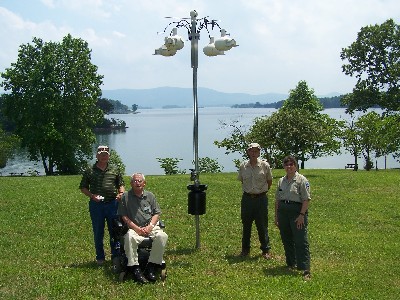Gene Chianelli of The Friends and Bill Pecoraro of The Purple Martin Conservation Association were able to attract martins to nest and establish a colony of three pair in 2014. This year two birds showed up about mid April, followed by more as the months wore on. All six gourds were first filled by birds that fledged from last year's crop. They were one year old and considered too young to mate. By early May the young martins were displaced by more mature males and females who will keep the colony going this year. The mature males pick their mates and the pairs will stay together and share raising their young.
The colony is located in a beautiful spot next to the park Discovery Center where visitors to the park can sit and watch the birds. Jet Lawler, the Park Naturalist will be offering nature classes that will include nest inspections. They do not mind the disturbance. Last year Jet had a ladder so the little ones could get good look inside the gourd.
 |
 |
| Bill Pecoraro, Gene Chianelli, Ranger "Jet" Lawler and Assistant Ranger Goode |
Gourds which Martins prefer |
Purple Martins (Progne Subis) are the largest member of the swallow family in North America. Of the three races (subspecies) Progne subis subis is the only subspecies breeding in eastern North America. They migrate northward from South America beginning in late winter and arrive in Virginia from March to April. They are long distance travelers - some banded birds have been tracked 13,000 miles! They only nest and reproduce in North America that is why it is so important to provide good nest sites here. Due to deforestation and climate change their numbers are in decline.
Purple Martins spend the non-breeding season in Brazil then migrate to North America to nest. East of the Rockies they are totally dependant on human-supplied housing. They were recognized by Native Americans to be beneficial to their gardens because they controlled insects. To encourage nesting near their settlements, they hollowed out gourds for housing.
The pair-bond of Purple Martins is monogamous. The male and female cooperate equally in building the nest. The female lays two to seven eggs at a rate of one per day. The female incubates the clutch for fifteen days. The parents both feed the young continuously for 26-32 days. The young continue to be dependant on the parents for an additional one to two weeks after fledging.
Martins only eat flying insects which they catch in flight Their diet consists of dragonflies, damselflies, flies, midges, mayflies, stinkbugs, leafhoppers, Japanese beetles, June bugs, butterflies, moths, grasshoppers, cicadas, bees, wasps, flying ants and ballooning spiders. Martins are day time feeders and feed high in the sky. Since Martins feed only flying insects, they are extremely vulnerable to starvation during extended periods of cool and/or rainy weather.
Anyone wishing to know more should contact The Friends or The Purple Martin Conservation Association.

